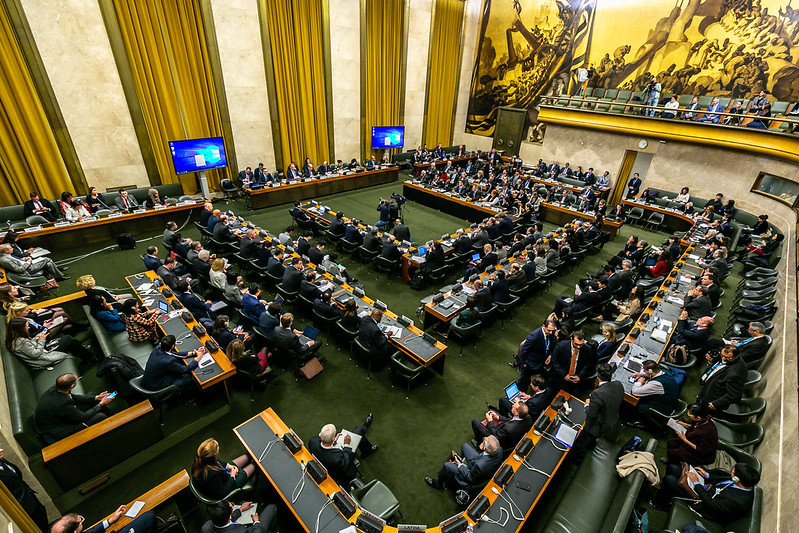GROUP OF GOVERNMENTAL EXPERTS OF CCW STATES PARTIES TO MEET IN GENEVA FROM 6 TO 10 MARCH 2006

The Thirteenth Session of the Group of Governmental Experts of the States Parties to the 1980 Convention on Prohibitions or Restrictions on the Use of Certain Conventional Weapons Which May Be Deemed to Be Excessively Injurious or to Have Indiscriminate Effects (CCW), established by the Second Review Conference of the States Parties to the Convention on 21 December 2001, will be held from 6 to 10 March at the Palais des Nations in Geneva. The Group will hold its Fourteenth Session from 19 to 23 June 2006 and its Fifteenth Session from 28 August to 6 September 2006.
The Meeting of the States Parties to the Convention held on 24 and 25 November 2005 decided that the Third Review Conference shall be held in Geneva from 7 to 17 November 2006 and that all necessary preparations for the Review Conference would be undertaken within the framework of the existing Group of Governmental Experts. The States Parties appointed Ambassador François Rivasseau of France as President-designate of the Third Review Conference, as well as Ambassador Edvardas Borisovas of Lithuania as the Coordinator on Explosive Remnants of War and Ambassador Carlos Antonio da Rocha Paranhos of Brazil as the Coordinator on Mines Other Than Anti Personnel Mines. The President-designate is tasked with overseeing the follow-up work arising from this Meeting, and his mandate comprises the preparation of the Third Review Conference; the promotion of the universalization of the Convention and its Protocols; undertaking consultations on the issue of possible options to promote compliance with the Convention and its annexed Protocols; as well as on the possibility to establish a sponsorship programme under the Convention and on the modalities of such a programme.
Furthermore, the 2005 Meeting of the States Parties agreed on new mandates for the two respective GGE working groups on Explosive Remnants of War (ERW) and Mines Other than Anti-Personnel Mines (MOTAPM).
On the issue of ERW, the Meeting decided that the Group of Governmental Experts would continue to consider, including through participation of legal experts, the implementation of existing principles of International Humanitarian Law and to further study, on an open-ended basis, with particular emphasis on meetings of military and technical experts, possible preventive measures aimed at improving the design of certain specific types of munitions, including sub-munitions, with a view to minimising the humanitarian risk of these munitions becoming explosive remnants of war. Exchange of information, assistance and co-operation would be part of this work. The Group will report on the work done to the Third Review Conference.
On the issue of MOTAPM, the Meeting decided that the Group would continue to consider all proposals put forward since the establishment of the Group with the aim of elaborating appropriate recommendations for submission to the Third Review Conference. Meetings of military experts shall also be conducted to provide advice on these activities.
The Convention on Certain Conventional Weapons (CCW) is also known as the Inhumane Weapons Convention. The structure of the CCW – a chapeau Convention and annexed Protocols – was adopted in this manner to ensure future flexibility. The purpose of the Convention is to ban or restrict the use of specific types of weapons that are considered to cause unnecessary or unjustifiable suffering to combatants or to affect civilians indiscriminately. The CCW with its three annexed protocols were adopted on 10 October 1980 and opened for signature for one year from 10 April 1981. A total of 51 States signed the Convention, which entered into force on 2 December 1983. Currently 100 States are party to the Convention with a further 6 having signed but not yet ratified. The initial three protocols are Protocol I on Non-Detectable Fragments (which has 98 States parties), Protocol II on Prohibitions or Restrictions on the Use of Mines, Booby Traps and Other Devices (87 States parties) and Protocol III on Prohibitions or Restrictions on the Use of Incendiary Weapons (93 States parties). Subsequently, Protocol IV on Blinding Laser Weapons entered into force on 30 July 1998 (which now has 81 States parties), and Protocol II, as amended on 3 May 1996, entered into force on 3 December 1998 (85 States parties).
The most recent of the Protocols annexed to the Convention, Protocol V on Explosive Remnants of War was adopted on 28 November 2003 by the Meeting of the States Parties to the Convention. The Protocol is intended to eradicate the daily threat that such legacies of wars pose to populations in need for development and to humanitarian aid workers operating in the field to help them. Since its adoption, 16 States have thus far notified the UN Secretary-General, as depositary of the Convention, of their consent to be bound by Protocol V.
Moreover, at the Second Review Conference in 2001, the States Parties agreed to expand the scope of the Convention to also cover internal armed conflicts as well as armed conflicts of an international nature. This amendment to the Convention has already entered into force on 18 May 2004 and 44 States Parties have now ratified the amendment and have submitted their instruments of ratification to the Depositary.
For use of the information media; not an official record
DC06011E

